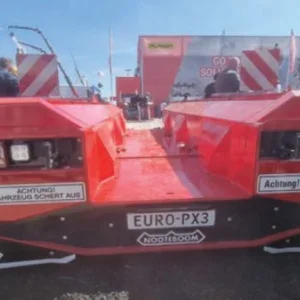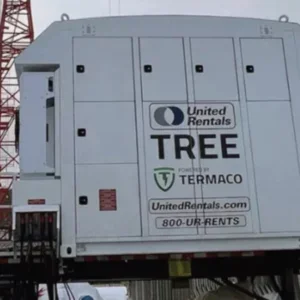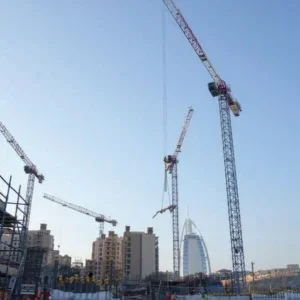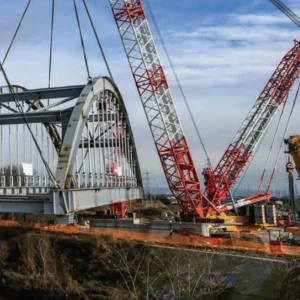Complex river and rail deliveries, advanced use of time-saving premade factory components, reduction of disruptive street closures, access to difficult underground locations and advanced heavyweight precast installation, are all aspects of work now underway on the Thameslink railway upgrade. Most would be impossible or much more laborious but for the versatility and capacity of modern cranes and lifting mechanisms.
Crane lifts, strand jacks and ram pushes come to the fore particularly for the Blackfriars bridge across the Rºiver Thames, while Farringdon station renovation and extension has relied on major heavy lifts to help deal with its awkward location surrounded by busy streets close to the centre of London’s City financial district. Large, up to 800t mobile crane operations have been used at both sites.
Both stations are undergoing virtual rebuilds in very congested and complicated locations. London Bridge station will also be rebuilt eventually, though this busy commuter interchange and terminus with its complex viaducts is only scheduled to start work later.
All three stations are key projects in the upgrade of the increasingly important Thameslink north-to south rail link, one of the few passing right through London, with its crossing of the Thames at Blackfriars. Most of the conurbation’s other rail links finish at terminus stations around London, like Waterloo or Euston.
North of the river the original Victorian line passed through a short tunnel to link to King’s Cross and a route north to Luton. The tunnel was closed before the Second World War however and only finally renovated, electrified and re-opened as a minor suburban rail service in the 1980s.
To the surprise of then British Rail, now Network Rail, the new Thameslink service has become more and more popular, largely because it fills a gap in the London Underground network which has no lines to south-east London and beyond, and because of its route out to Luton airport.
So the now overcrowded link is being massively upgraded to take many more trains, more through trains and longer ones of up to 12 carriages. £2bn pays for new trains and £3.5bn for civil engineering, rail, and signalling upgrading. Most stations will simply have lengthened platforms and new signalling, but the three in the central area will need to deal with very large increases in passenger numbers.
Across the river
The most visible will be Blackfriars station. Currently there are four platforms here, sitting at the north end of a rail bridge over the river. Two are terminals for south-east services and two are through lines to Farringdon and beyond. Below ground is an additional London Underground tube station for the District Line which runs along the northside Embankment, connecting at right angles to the rail lines.
A complete demolition of the nondescript station is underway. It will be rebuilt to give the rail and Underground services a futuristic new common entrance hall and ticketing facility. Beneath, the tube station is being simultaneously excavated and completely rebuilt.
The main building will link to a dramatic extension of the four platforms over the river. No longer will these simply sit at the north end under canopies, but will become the centre point of the station, stretching right along the bridge’s spans enclosed within a steel and glass superstructure. The longitudinal transparent box is destined to be a major architectural landmark close to St Paul’s Cathedral. Design is by main consultant, Jacobs.
At the south end a new “pavilion style” entrance building will be added, giving a direct connection to the river walk on the South Bank and the under-served south side.
All this demands major structural upgrading work. The river bridge itself, a five-arch masonry pier Victorian structure has to be stripped right down to renovate and strengthen the 57m long wrought iron arches. Piers will be widened to accommodate additional new arch sections being added alongside to old ones, to widen the station space above.
The job requires two phases, with trains running on two of the lines throughout and the other half of the bridge under 24 hour working, seven days a week. The vital live train services transfer to the rebuilt side halfway through, this Christmas, to allow the remainder to be done.
On the construction side the old rail tracks, steel deck and support posts, or spandrels, are ripped out leaving the wrought iron arch rib sections. Thousands of old rivets have to be deheaded and punched out to allow this to happen.
The parallel ribs which make up the width of the bridge, are inspected by the structural engineers, specialist bridge engineer subconsultant Tony Gee & Partners, and steel plate added where they are corroded. New steel arch sections are placed alongside the old, and new steel spandrels, deck plates and track built up, with new platforms and roof added last.
Key to all this work are five brand new Kobelco 70t mobile cranes, says Laurence Whitbourn, Network Rail’s senior programme manager. There is one for each span, because once work has started there is no deck on which to move to the next pier. The 33.4m boom cranes allow a strongly river-based logistical organisation for the work, which makes economic and, equally importantly, environmental sense. It also reduces truck deliveries around the site which has the busy Blackfriars road bridge on one side, two busy City roads on the north and the embankment on the south. Reducing road congestion is one aim, pleasing Transport for London and the local boroughs, and speeding delivery for the site is another, pleasing the contractor Balfour Beatty and client Network Rail.
The units can lift a maximum 21.1t at 7.3m radius, allowing them to move some 8,000t of old scrap into barges for disposal downstream, while 14,000t of new steel is delivered the same way.
“We have a loading point at Thames Wharf near Greenwich” says Whitbourn. A 120t Hitachi mobile works here using a 30.4m boom. It has a maximum 60t capacity at 8m, sufficient for the big rib arch sections fabricated in the Midlands and delivered by truck. On site the first of these are currently being lifted into position by a 100t barge-mounted Liebherr LTR1100 which will remain on site for the rest of the project.
The five Kobelcos were themselves lifted into position onto the bridge track level by a 135t Kobelco operating with a 45.7m boom on the track viaduct to the south of the site. The same crane also lifted in two smaller 25t Hitachi mobiles with 21m booms which are used for general site duties, lifting up to 7.2t at 4.5m. All these cranes are on hire from Balfour Beatty Crane Hire, the obvious choice.
Critical for most of the crane operations is continuous interaction with the Port of London Authority, which only allows lifts from the water if bridge spans are closed to river traffic. During the summer tourist boat season especially this can mean a need for close liaison to obtain permissions.
The cranes also have to be aware of the live railway alongside, which limits their daytime slews. At night however, when services are stopped between 10pm and 5am, they are able to traverse a full 360 degrees. Weekend possessions also allow this. For the building work at either end of the project, there are luffing jib tower cranes, two on the north side and another south.
Several special operations have required larger cranes too. A 500t mobile was hired for two weekends early on to lower 39 special steel guard sections down a ventilation shaft into the Tube station. The 8t U-shaped units sit on special temporary steel tracks along the station platforms to create a protective hood over the tracks. The guard means tube trains can continue to run through while demolition, piling, excavation and major concrete building operations go on all around to create a renewed and expanded Underground station and its links to the entrance building and ticket concourse.
A 500t mobile was also used during site clearance above the station when the old Blackfriars entrance building was removed. “It reached over the crowded site to remove a Vierendeel truss” says Whitbourn.
Blackfriars has also seen a significant bridge slide operation. The station comprises several linked bridges which continue the track beyond the main river bridge. One small linking bridge on the north side had to be replaced in order to allow a track changeover halfway through the project. The through tracks are to be given a slew connection onto the newly renovated downstream half of the bridge this Christmas, allowing the upstream side to be worked on. To do it the connector bridge needed to fan out for new track and so a new wider version was built alongside the old one, on trestle supported steel slide rails. The concrete trough section was pushed into position by hydraulic jacks in the Christmas holiday period last year.
One other major lifting operation is needed. The second phase work will widen the bridge even more, using some old piers from a second rail bridge which used to run alongside. Its deck was removed in the 1980s but the iron columns remain, in four rows of three, matching the Blackfriars pier locations. The closest pier from the triplets will be cut back to the masonry bases which are to be built up with concrete. A precast section will then link this to the main station bridge allowing three more steel rib sections to be added to widen the spans upstream.
For this operation next year a strand jack is anticipated, lifting the precast from a barge and again avoiding any disruption in the streets above.
The edge of the City
The £250m Farringdon station renewal meanwhile, which also began work at the end of 2008, has no special lifting and fewer onsite cranes but is making much greater use of heavy craneage, working from outside the site.
The station sits in a narrow cutting, originally the Fleet River valley which was boxed in and built up by retaining walls and two level column-supported basements, in the time of Charles Dickens. Smithfield meat market is close by and numerous offices, shops, flats and restaurants. Roads enclose the site on four sides including the busy Farringdon road.
Four lines run through, two for Thameslink and two for London Underground which peels off towards the City on the south side, where there are small sidings. An old rail spur also peeled away but this is being removed to make space for a new second ticket hall and to allow extension of the existing platforms.
“The platforms can only be lengthened southwards because of a steep incline into tunnel for Kings Cross on the north end” says project manager for Network Rail, Richard Walker.
Complicating this work is the fact that the platform level is the “basement” underneath brick arches which support a listed Victorian and Edwardian ticket hall above, which cannot be altered. But the four interlocking arches have to be removed and new bridge supports put in for the building, and for the road running in front of its entrance at the modern, built-up, “ground level”. Complex underpinning is needed and there will be new station rooms added too.
Further complications arise because the future Crossrail scheme’s east-west tunnels cross through the south end of the site. Here there will be a station below ground with links to Thameslink and the Tube.
Crossrail’s ticket hall at the southern end of the station, will extend the new Thameslink hall into a common entrance on a site which has already been cleared of an old office building. The additional space is free for the moment which helps Thameslink; in return it does some preparation for Crossrail.
Initial work on the site has involved some major lifting from the small streets alongside. First came a new footbridge halfway along the station which gives it a new entry and exit route, helping passenger flows during construction and eventually to be a permanent entrance from a new side concourse which is being added to the length of the station along the small Turnbull street.
For this lift the Costain-Laing O’Rourke joint venture contractor hired an 800t Demag AC2000 via its craneage supplier Select Plant Hire/Select Tower Cranes which in turn uses Ainscough Cranes for the big lifters. The machine was used with full outriggers and 160t of ballast with a 55.5m main boom, which allowed it to place the parts for the new steel footbridge at a maximum radius of 34.8m and maximum load of 38t. A second 100t LTM 1100 was used for the ballast placement during the week long operation.
“We had to build up a part of the permanent basement foundations with RMD Megashors to take the outriggers” says Walker. He adds that the maze of Victorian basements and retaining structures requires that every heavy equipment movement follows only after careful ground inspection. Other outriggers were placed on spreader mats.
Meanwhile a variety of heavy cranes have been used to place plant and machines for the basement level work on the new ticket hall. Some very large diameter piles are needed here for later multistorey office construction and rigs for these were lowered in using a 500t Liebherr LTM 1500 which was short rigged with 105t of ballast. Loads included a 73t Bauer BG36 piling rig at 13.5m, a 44t Liebherr LR1130 crawler crane lifted at 16m and a Cassagrande B180 60t piling rig again at 13.5m.
A 250t Liebherr LTM 1250 on full outriggers and 72.5t of ballast has also been used for lifting in a Sumitomo SCX 800 crawler crane, a load of 49.4t at 11m radius.
Two other major lifts are planed for later which will require a 300t crane to lift in precast concrete elements. There is also to be a new platform roof to be installed in the main existing station. Prefabricated steel frame sections will be lifted using another 500t crane, primarily to achieve the long reach needed out over the tracks.
All these lifts are done at weekends when the busy commuter station passenger throughput is much reduced and street and station closures are less disruptive.
Biggest crane of all will be a 1,600t Terex CC2800 crawler which will be needed on site for some five months during which time it will erect the superstructure for the new ticket hall using a 54m main jib and a 12m fly jib.
On site meanwhile general lifting duties are being done with a Comedil luffing jib tower crane, a CT180 with a 54m high tower and 35m jib. A second CT630 with a 42m tower and a 60m jib will join it later. Both are fitted with SMIE electronic controllers to limit their jib movements to prevent overflying of site boundaries of tracks during operational hours, a critical matter in a station which remains live throughout the works.
Finally of course there will be some major lifting to be done at London Bridge. But that is another complicated story.






